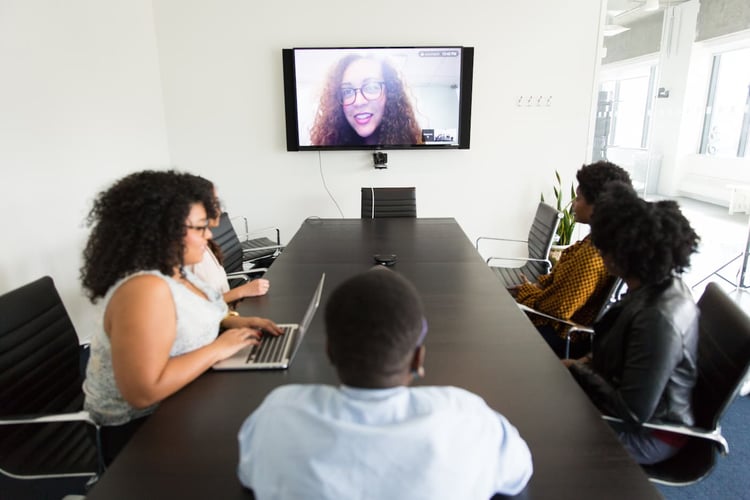As teams gradually return to the office, "hybrid" work is the newest normal, where some employees are offsite and some onsite. A McKinsey study found that 90 percent of businesses plan to support hybrid work environments. We all got used to all-remote work and Zoom meetings. Next, mixed office-remote work will make hybrid meetings standard. When was the last time you had a traditional voice-only conference call?
Hybrid meetings are pretty different from in-person meetings or all-virtual meetings. Getting them right takes purpose and planning. The Harvard Business Review said that hybrid meetings are "easy to do poorly and hard to do well." The greatest challenge is, as stated by Microsoft CEO Satya Nadella, "to ensure those joining remotely are always first-class participants."
Based on Prialto's experience training thousands of virtual assistants to participate in hybrid meetings over 12+ years, here are eight best practices to make mixed remote-office meetings successful.
1. Invest in Audio
Nothing is more frustrating in a video call than poor audio. Giving your remote employees high-fidelity microphones makes communication better and more transparent for everyone. "What? What? What?" does not make for a valuable meeting and leaves the remote participants at a disadvantage.
The same is true for the onsite meeting rooms. If everyone gathers around a single microphone, it can be challenging to hear someone far from it. Make sure your conference rooms have microphones that capture voices from a distance.
2. Upgrade Internet Connections
For many, working from home was makeshift at first, and we got by on whatever home internet connection we had. But freezing on-screen and garbled speech impedes meeting effectiveness and participation.
If you can, get your remote employees the highest bandwidth connections available. It might be costly, but not as expensive as office space.
3. Everyone on Camera
Yes, there will be exceptions, but as a rule, everyone should see one another face to face on camera. If remote workers are out of sight or office workers are hidden from view, you cannot see body language, attentiveness, or engagement, which are critical to effective communication.
One option is to have conference room participants use their laptops to Zoom into the meeting. Or you can set up huddle room video conferencing so that an in-room camera captures every participant around the table. Some businesses use large screens to make offsite participants more lifelike.
4. Facilitate Conversations
It is essential that everyone engages and participates verbally and visually in hybrid meetings. Getting engagement may require the leader of the meeting to call on people from time to time to balance communication, ownership, and accountability. You can put an order of people's participation in the chat so that everyone can prepare to speak.
5. Prepare in Advance
Confirm attendance with everyone in the meeting beforehand. Make sure everyone has the meeting agenda and time to contribute to it or ask questions before meetings. If you do not have an agenda, is the meeting needed? Ditto any prep materials like reports or slides. Put everyone on the same playing field for participation. Make sure everyone knows why you are meeting, why they are there, and what you expect.
6. Start on Time
It is frustrating for remote attendees to be, quite literally, in the dark when a meeting is supposed to begin. Start on time or send a chat before the starting time to remote attendees to tell them when they should log in. A good safety tip is to test the tech ahead of time to ensure the connection is seamless and does not cause delays.
7. Use a Company Virtual Backdrop
We all got used to seeing each other's home offices (along with pets and children), but that exacerbates the perception of remote workers as "different." The objects in the background can distract the office participants too. A company virtual backdrop neutralizes those issues and creates a more professional setting for everyone in the meeting. Standard virtual backdrops also reduce the time remote employees need to prepare their workspace. In most video conferencing software, virtual backdrops are jpeg or png files that are easily uploaded using video settings.
8. Give and Receive Feedback
We all know that great meetings are made, not born. Successful meetings require planning, leadership, and consistent feedback loops. If remote employees do not seem to be participating equally, let them know your perception and ask if they feel left out. You may need to coach them on how they come across. But ask about their experience before assuming there is a problem. At the same time, ask all employees how to improve the meetings.
Hybrid Meeting Best Practices are Meeting Best Practices
Hybrid meeting best practices are best practices for all business meetings. Having the right technology, facilitation, preparation, respect for starting times, and feedback loops should be standard for any meeting for any business team. It may be easier to be casual and overlook some of these steps when everyone is in the office or remote because everyone is in the same boat, and the frustrations are shared. The "second class" syndrome is more likely in a hybrid scenario, but you should always treat everyone on your team like a first-class member.
For more information about Prialto’s managed virtual assistant service, download this guide.

